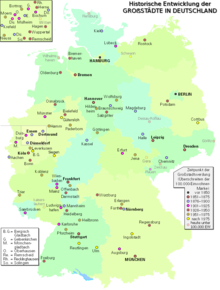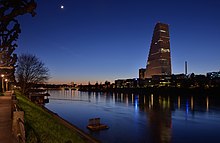Big city
According to a definition of the International Statistics Conference of 1887, large cities are all cities with at least 100,000 inhabitants . According to this definition, there were around 4,000 large cities worldwide in 2008.
The other definitions made at the time are the country town with fewer than 5,000 inhabitants, the small town with under 20,000 inhabitants and the medium-sized town with under 100,000 inhabitants.
Meanwhile, cities with more than 1 million inhabitants are as big city or metropolis and even bigger agglomerations sometimes as a megacity called.
Germany

Currently (as of Dec. 31, 2018) there are 81 large cities in Germany , of which 30 (37%) are in North Rhine-Westphalia . Four are metropolises, another ten have more than half a million inhabitants. At the end of 2006 there were 82 major cities. Another ten cities in Germany (within today's borders) had more than 100,000 inhabitants at least once in the 20th or 21st century, so that there are a total of 90 cities that were or are once big cities.
In Germany, according to the Federal Office for Building and Regional Planning , a city is further subdivided into a "Smaller City" with 100,000 to 500,000 inhabitants and a "Large City" with more than 500,000 inhabitants.
In 2006, the then 82 German cities had a total of 25,449,822 inhabitants, which means that 30.9% of the total German population (as of December 31, 2006: 82,315,000 inhabitants) lived in cities with more than 100,000 inhabitants. 73 large cities are independent or urban districts . Major cities belonging to the district are Göttingen ( Lower Saxony ), Reutlingen ( Baden-Württemberg ), Recklinghausen , Bergisch Gladbach , Neuss , Paderborn and Moers (all North Rhine-Westphalia). With the exception of Moers ( Wesel district with seat in Wesel ), these cities are the seat of the respective district administration. Hanover (Lower Saxony), Aachen (North Rhine-Westphalia) and Saarbrücken (Saarland) are part of a special kind of local authority association .
At the end of 1942 Berlin had around 4.5 million inhabitants, in mid-1945 due to the war only 2.8 million, which corresponds to a decrease of 1.7 million or 38% within three years. At the end of 2008, Berlin had around 3.4 million inhabitants. This corresponds to a decrease of 1.1 million or 24% compared to the high in 1942. Thus Berlin is with stand 2008 world now on rank 54 , but in the European Union , the largest in Europe 's fifth largest city by population. Leipzig , Dresden , Nuremberg and Duisburg are the cities whose population has exceeded or fallen below the half-million mark several times in the post-war period .
Austria

According to Statistics Austria, Vienna (1,897,491 inhabitants), Graz (288,806 inhabitants), Linz (205,726 inhabitants), Salzburg (154,211 inhabitants), Innsbruck (132,110 inhabitants) and Klagenfurt am Wörthersee (100,817 inhabitants) are major cities in Austria in 2019. In 2019, a total of 2,779,161 people lived in these six major cities. 31.4% of the population (2019: 8,858,775 inhabitants) lived in cities with more than 100,000 inhabitants.
Switzerland
In Switzerland, Zurich (415,367 inhabitants), Geneva (201,818 inhabitants), Basel (172,258 inhabitants), Bern (133,883 inhabitants), Lausanne (139,111 inhabitants) and Winterthur (111,851 inhabitants) are considered major cities. Of the approximately 8.6 million inhabitants of Switzerland, around 13.6% live in cities with more than 100,000 inhabitants.
See also
literature
- H. Häußermann (Ed.): Großstadt. Sociological keywords. 2nd Edition. Opladen 2000, ISBN 3-8100-2717-0 .
- B. Schäfer, K. Trippel: Stadtlust. To live on happiness in the big city. Munich 2013, ISBN 978-3-7645-0490-8 .
- G. Simmel: The big city and the intellectual life. Frankfurt am Main 2006, ISBN 3-518-06857-1 .
Web links
Individual evidence
- ↑ Propositions pour arriver à une comparabilité internationale des ouvrages de recensement , M. Körösi, Bulletin de l'Institut international de statistique, 1887, volume 2, number 1, p. 212, accessed on May 10, 2014.
- ↑ Big cities worldwide on Mongabay .com
- ↑ Type of city and municipality ( memento of the original from October 1, 2017 in the Internet Archive ) Info: The archive link was inserted automatically and has not yet been checked. Please check the original and archive link according to the instructions and then remove this notice.
- ↑ Federal Statistical Office Germany: Population status, accessed on December 25, 2007 ( Memento of the original from December 30, 2007 in the Internet Archive ) Info: The archive link was inserted automatically and has not yet been checked. Please check the original and archive link according to the instructions and then remove this notice.

